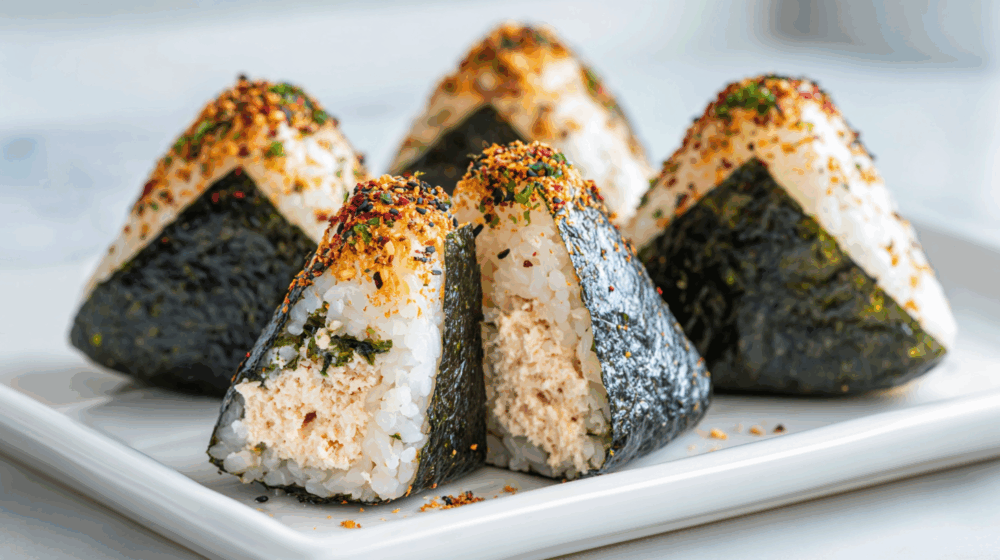
Ingredients
- 1½ cups 350g Japanese short-grain rice
- 2 cups 500ml cold water
- 2½ tablespoons rice vinegar
- 1½ teaspoons sugar
- ½ teaspoon fine salt
- 1 can 185g tuna in water, drained
- 2-3 tablespoons Japanese mayonnaise
- 1 tablespoon fresh lemon juice
- Freshly ground white pepper to taste
- 2 tablespoons fresh chives finely chopped
- 6 sheets nori seaweed
- 2 tablespoons furikake seasoning
Instructions
- Rinse the Japanese rice under cold water until the water runs clear. Place in a medium saucepan with 2 cups water. Cover and cook on low-medium heat for 30 minutes until tender. Remove from heat and let steam for 10 minutes.
- Transfer cooked rice to a large sheet pan. Spread in a thin layer. Sprinkle rice vinegar, sugar, and salt over the rice. Using a rice paddle, fold the seasoning into the rice and spread out to cool to room temperature.
- Drain the tuna completely and place in a mixing bowl. Flake with a fork. Add mayonnaise, lemon juice, white pepper, and chopped chives. Mix well and taste for seasoning.
- Wet your hands with water and sprinkle with salt. Take a handful of rice (about ½ cup) and create a small well in the center. Add 1 teaspoon of tuna filling. Cover with more rice and gently form into a triangular shape, pressing firmly but gently.
- Cut nori sheets into thirds lengthwise. Wrap the bottom portion of each rice ball with nori. Sprinkle the top with furikake seasoning. Serve immediately or wrap individually in plastic wrap.
I never thought I’d become obsessed with something as simple as rice and seaweed, but here we are. My journey with onigiri started during a particularly hectic week when I was desperately searching for lunch options that wouldn’t leave me feeling sluggish by 2 PM. That’s when I discovered these humble Japanese rice balls, and honestly, they’ve revolutionized my entire approach to quick, satisfying meals.
The first time I made onigiri, I was skeptical. How could something so basic—essentially seasoned rice with a simple filling—be genuinely satisfying? But there’s something almost meditative about the process of shaping warm, perfectly seasoned rice in your palms. The salt on your hands, the gentle pressure required to form the triangular shape, the anticipation of that first bite—it’s become one of my favorite kitchen rituals.
What struck me immediately was how incredibly practical these rice balls are. Unlike sandwiches that can get soggy or salads that wilt, onigiri maintains its integrity for hours. I’ve packed them for hiking trips, eaten them during long work meetings, and even served them at dinner parties as an elegant appetizer. They’re portable perfection in edible form.
The tuna mayo filling I’ve perfected over countless batches hits all the right notes. The creamy mayonnaise balances the saltiness of the tuna, while fresh chives add a subtle sharpness that prevents the filling from becoming too rich. I’ve experimented with different variations—sometimes adding a squeeze of sriracha for heat or substituting the chives with finely diced green onions—but this combination consistently delivers.
The rice itself deserves special attention. Using proper Japanese short-grain rice isn’t just pretentious chef talk; it’s absolutely essential. Regular long-grain rice simply won’t hold together properly, and you’ll end up with a frustrating mess rather than neat, handleable rice balls. The starch content in short-grain rice creates that perfect sticky texture that allows the onigiri to maintain its shape while still being tender to bite.
I’ve learned that timing is everything with the rice seasoning. Adding the vinegar, sugar, and salt mixture while the rice is still warm allows the grains to absorb the flavors completely. Spreading the rice on a sheet pan speeds up the cooling process and prevents overcooking from residual heat. This might seem like an extra step, but it makes an enormous difference in the final texture.
The nori wrapping serves multiple purposes beyond just aesthetics. It provides a satisfying textural contrast—that initial crispy bite giving way to the soft, seasoned rice. More practically, it creates a natural handle, making onigiri incredibly easy to eat without utensils. I’ve found that cutting standard nori sheets into thirds lengthwise provides the perfect amount of coverage without overwhelming the rice.
Making onigiri has taught me to appreciate the beauty of simplicity in cooking. There are no complex techniques or exotic ingredients required, yet the end result feels sophisticated and deeply satisfying. The key lies in executing each simple step with care—properly seasoning the rice, balancing the filling, shaping with the right amount of pressure.
I’ve discovered that onigiri works beautifully for meal prep. I make a large batch on Sunday afternoons, wrapping each one individually in plastic wrap. Throughout the week, I can grab one for breakfast with my morning coffee, pack a couple for lunch, or even enjoy one as an afternoon snack. They keep well in the refrigerator for up to three days, though I find they’re best within the first 24 hours.
The versatility of fillings keeps things interesting. While tuna mayo remains my go-to, I’ve successfully used leftover teriyaki chicken, mashed avocado with a touch of lime, and even simple pickled plum for a more traditional approach. The key is ensuring any filling is well-seasoned and not too wet, which could make the rice soggy.
What I find most appealing about onigiri is how it challenges Western assumptions about what constitutes a proper meal or snack. There’s no need for elaborate preparations or multiple components. Sometimes the most satisfying food is also the most straightforward. These rice balls prove that with quality ingredients and careful technique, even the humblest combinations can be extraordinary.
The ritual of making onigiri has become a form of mindful cooking for me. The repetitive motions of shaping the rice, the focus required to achieve the proper triangular form, the satisfaction of seeing a neat row of finished rice balls—it’s surprisingly therapeutic. In our increasingly complex world, there’s something grounding about creating something so fundamental yet perfect with your own hands.
Whether you’re looking for a healthier alternative to processed snacks, a unique addition to your lunch rotation, or simply want to try your hand at authentic Japanese home cooking, onigiri delivers on every level. They’re proof that the best recipes often come from necessity rather than luxury, created by people who understood that good food doesn’t have to be complicated to be deeply satisfying.




